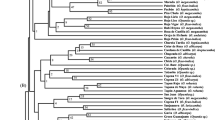Summary
RFLPs were used to study the genetic relationships of 31 Portuguese coles (Brassica oleracea L.) representing the different ecotypes or landraces grown in Portugal. Other cole crops such as Jersey kale, Chinese kales, common cabbages, broccolis and cauliflower, two nine-chromosome wild species, and one accession of turnip also were included to determine the evolutionary relationships of Portuguese coles to other related coles. Principal coordinates and cluster analyses were conducted using a package of computer programs and RFLP data from 55 nuclear DNA probes, detecting 291 polymorphic restriction fragments. The results showed that the 48 accessions clustered into five groups: (a) a dispersed group with turnip and the wild brassicas; (b) Chinese kales; (c) broccolis and cauliflower; (d) a disperse group including Algarve and Jersey kales, thousand head kale, cabbages, and savoy cabbage; (e) a large and compact group containing all Portuguese tronchuda cabbages and kales. This unique and closely related group containing Portuguese tronchuda cabbages and kales could be further divided into five subgroups corresponding to the major areas of cultivation. The phenetic groupings of Portuguese tronchuda cabbages and kales based on RFLP data corresponded more with their geographic origins (collecting sites) than with their morphological similarities. A mechanism involving geographic isolation and frequent intercrossing within local areas is proposed to explain genetic relationships among Portuguese tronchuda cabbages and kales.
Similar content being viewed by others
References
Bailey, L.H., 1930. The cultivated brassicas II. Gentes Herbarium 2, Fasc. 5: 211–267.
Cerca, M.C., 1946. Subsídios para a caracterização e identifição de algumas formas cultivadas da espécie Brassica oleracea L. nacionais ou de há muito cultivadas em Portugal. Relat. Final Curso Eng. Agrónomo. Univ. Técnica de Lisboa. Lisboa, 156 p.
Crouch, M.L., K.M. Tenbarge, A.E. Simon & R. Ferl, 1983. cDNA clones for Brassica napus seed storage proteins: evidence from nucleotide sequence analysis that both subunits of napin are cleaved from a precursor polypeptide. J. Mol. Appl. Genet. 2: 273–283.
De Candolle, A.P., 1924. Memoir on the different species, races, and varieties of the genus Brassica (cabbage) and the genera allied to it, which are cultivated in Europe. Transact. Hort. Soc. London 5: 1–43.
Figdore, S.S, W. Kennard, K.M. Song, M.K. Slocum & T.C. Osborn, 1988. Assessment of the degree of restriction fragment length polymorphism in Brassica. Theor. Appl. Genet. 75: 833–840.
Gardé, A. & N. Gardé, 1976. Culturas hortícolas, 4 ed. Clássica Editora, Lisboa, 449 p.
Gower, J.C., 1966. Some distance properties of latent root and vector methods used in multivariate analysis. Biometrika 27: 325–338.
Monteiro, A.A. & P.H. Williams, 1989. The exploration of genetic resources of Portuguese cabbage and kale for resistence to several Brassica diseases. Euphytica 41: 215–225.
Nogueira, A.P., 1986. Alguns aspectos da caracterizaçõ e da selecção da couve tronchuda (Brassica oleracea L. var. tronchuda Bailey). Relat. Est. Curso Eng. Agrónomo. Univ. Técnica de Lisboa. Lisboa, 47 p.
Osborn, T.C., D.C. Alexander & J.F. Fobes, 1987. Identification of restriction fragment length polymorphisms linked to genes controlling soluble solids content in tomato fruit. Theor. Appl. Genet. 73: 350–356.
Rohlf, F.J., 1989. NTSYS-pc. Numerical taxonomy and multivariate analysis system, version 1.5. Exeter Publishing, Ltd., Setauket, New York.
Simon, A.E., K.M. Tenbarge, S.R. Scofield, R.R. Finkelstein & M.L. Crouch, 1985. Nucleotide sequence of a cDNA clone of Brassica napus 12S storage protein shows homology with legumin from Pisum sativum. Plant Mol. Biol. 5: 191–201.
Slocum, M.K., S.S. Figdore, W.C. Kennard, J.Y. Suzuki & T.C. Osborn, 1990. Linkage arrangement of restriction fragment length polymorphism loci in Brassica oleracea. Theor. Appl. Genet. 80: 57–64.
Sneath, P.H.A. & R.R. Sokal, 1973. Numerical taxonomy. The principles and practice of numerical classification. W.F. Freeman, San Francisco, 573 p.
Song, K.M., T.C. Osborn & P.H. Williams, 1988a. Brassica taxonomy based on nuclear restriction fragment length polymorphisms (RFLPs) 1. Genome evolution of diploid and amphidiploid species. Theor. Appl. Genet. 75: 784–794.
Song, K.M., T.C. Osborn & P.H. Williams, 1988b. Brassica taxonomy based on nuclear restriction fragment length polymorphisms (RFLPs) 2. Preliminary analysis of subspecies within B. rapa (syn. campestris) and B. oleracea. Theor. Appl. Genet. 75: 784–794.
Song, K.M., T.C. Osborn & P.H. Williams, 1990. Brassica taxonomy based on nuclear restriction fragment length polymorphisms (RFLPs) 3. Genome relationships in Brassica and related genera and the origin of B. oleracea and B. rapa (syn. campestris). Theor. Appl. Genet. 79: 497–506.
Song, K.M., M.K. Slocum, J. Suzuki, P.H. Williams & T.C. Osborn, 1991. A linkage map of Brassica rapa (syn. campestris) based on restriction fragment length polymorphism loci. Theor. Appl. Genet. (in press).
Williams, P.H. & C.B. Hill, 1986. Rapid-cycling populations of Brassica. Science 232: 1385–1389.
Author information
Authors and Affiliations
Rights and permissions
About this article
Cite this article
Dias, J.S., Lima, M.B., Song, K.M. et al. Molecular taxonomy of Portuguese tronchuda cabbage and kale landraces using nuclear RFLPs. Euphytica 58, 221–229 (1991). https://doi.org/10.1007/BF00025253
Received:
Accepted:
Issue Date:
DOI: https://doi.org/10.1007/BF00025253




